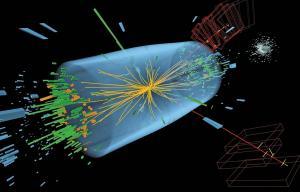Centro de Excelencia Severo Ochoa
Menú
Buscar

Exactly ten years ago, the ATLAS and CMS collaborations at CERN's Large Hadron Collider (LHC) announced the discovery of a new particle with characteristics similar to the Higgs boson. It was a milestone in science and captured the attention of the world. After François Englert and Peter Higgs were honored with the Nobel Prize in Physics a year later, together with the late Robert Brout, they predicted that a new fundamental field, known as The Higgs boson, would fill the universe, manifest itself as the Higgs boson and give elementary particles mass.
"The discovery of the Higgs boson marked a turning point in particle physics. It ended decades of research and marked the beginning of a new era of research focused on this very special particle," explains Fabiola Gianotti, Director General of CERN and ATLAS experiment spokesperson. "I recall the day of the announcement with emotion, a day of immense joy for the global particle physics community and all those who worked tirelessly for decades to make this discovery possible".
How has the journey been so far?
Several of the new particles discovered in 2012 by the international ATLAS and CMS collaborations closely resemble the Higgs boson predicted by the Standard Model. Was it really that long-sought particle? Within days of the discovery, ATLAS and CMS began investigating in detail whether the particle's properties matched those predicted by the Standard Model.
As a result of the decay of these new particles into two photons, experiments have shown that they have no intrinsic angular momentum or quantum spin, which is consistent with the Higgs boson predictions made from the Standard Model.
By contrast, all other known elementary particles have a spin.
Observing Higgs bosons produced and decaying into W or Z bosons, ATLAS and CMS found the latter acquire their mass through interactions with the Higgs field, just as predicted by the Standard Model.
In addition, experiments have shown that top quarks, bottom quarks, and tau leptons, which are the heaviest fermions, get their mass from interaction with the Higgs field, as predicted by the Standard Model. The Yukawa interaction, which is part of the Standard Model, has also been confirmed by these observations: it is mediated by the Higgs boson, and its force is not quantized, that is, not given by multiples of a certain unit.
Higgs boson mass is measured by ATLAS and CMS to a value of 125 billion electron volts (125 GeV) with a precision of almost one in a thousand. Together with the heaviest known elementary particle, the top quark, and other parameters, the mass of the Higgs boson helps us determine the vacuum stability of the universe.
There is still a lot of research to be done
Ten years later, what remains to be learned about the Higgs field and the Higgs boson? There is a lot. Can the Higgs field also give mass to the lighter fermions, or could there be another mechanism at work? Are the Higgs bosons elementary particles or composite particles? Can it interact with dark matter to reveal its nature? Higgs boson mass is generated by what? Has it got 'twins' or 'relatives'?
Identifying some of the answers to these and other questions will not only contribute to our understanding of the universe at its smallest scales, but will also shed light on some of the biggest mysteries of the universe, such as how it came to be as it is and where it may end up.
"The Higgs boson may point to further phenomena, including some that may result in dark matter in the universe," CMS spokesman Luca Malgeri says. AtLAS and CMS are researching all kinds of unexpected processes associated with the Higgs boson.
In some cases, the answers to these questions could be provided by LHC Run 3 data or later periods of accelerator operation, but in others the LHC cannot reach the answer, requiring a future "Higgs factory". Therefore, CERN and its international partners are investigating the technical and financial feasibility of a much larger and more powerful machine, the Future Circular Collider (FCC).
"High-energy colliders remain the most powerful microscope we have to explore nature at the smallest scales and uncover the fundamental laws that govern the universe," says Gian Giudice of CERN's Theory Department.

Social media